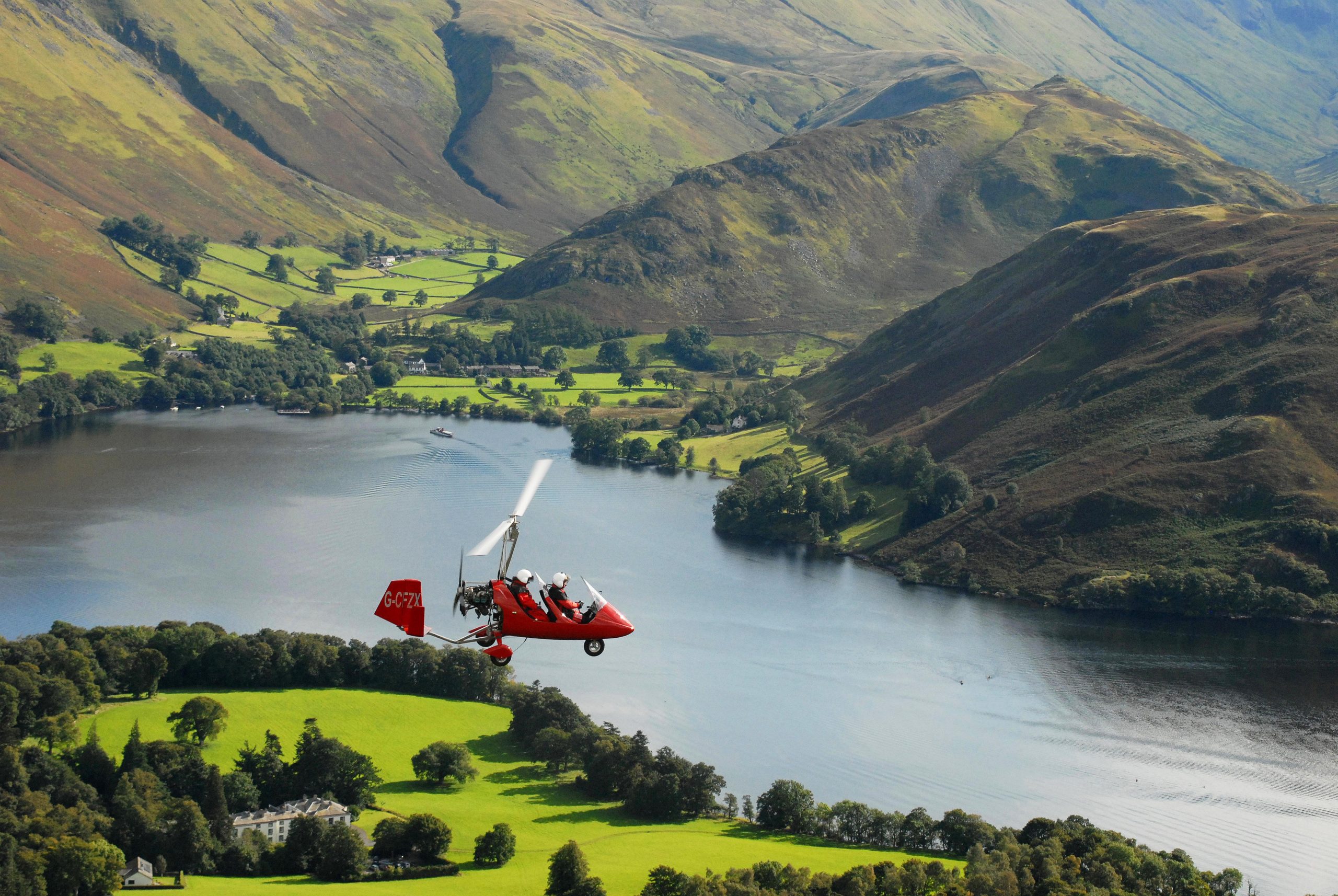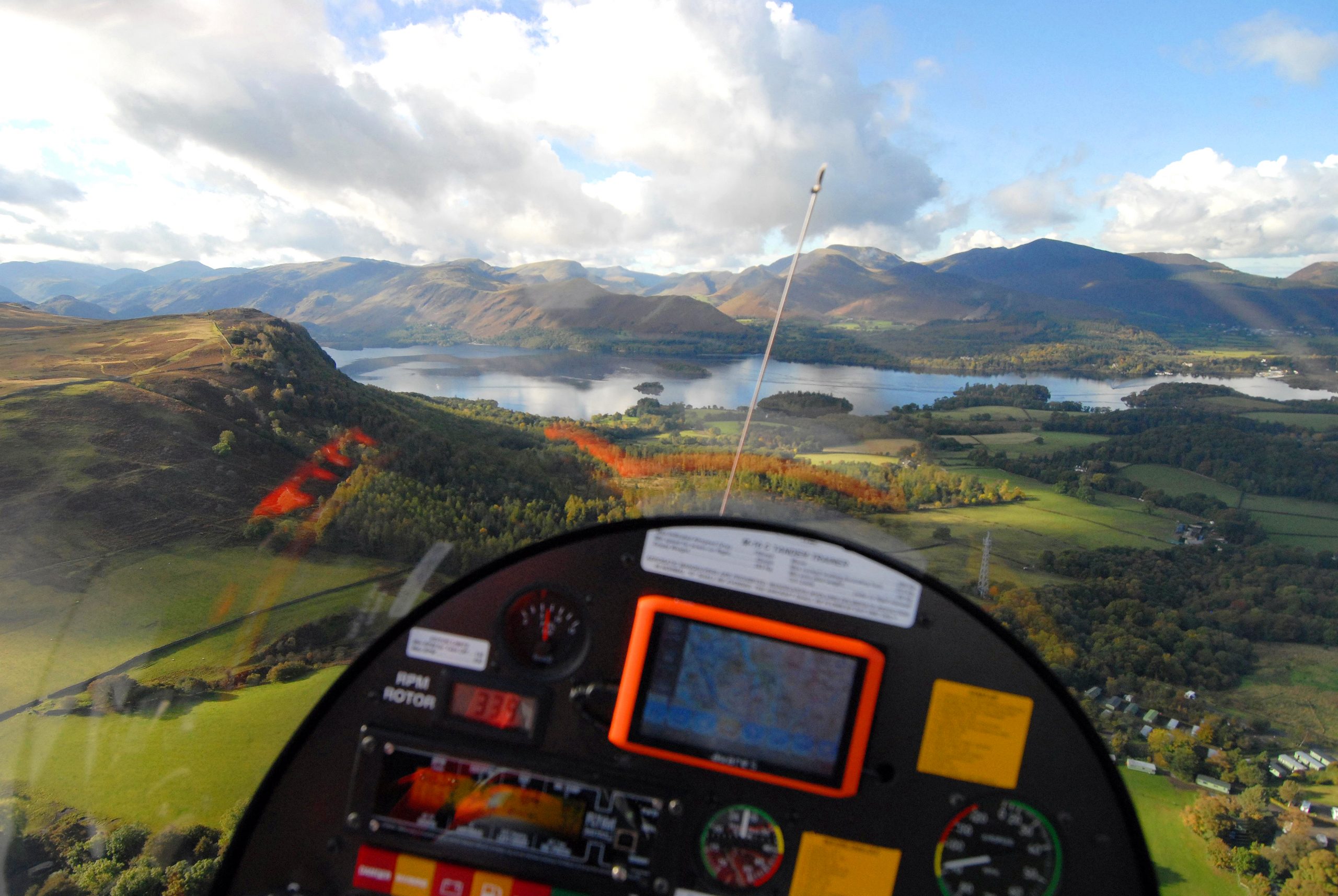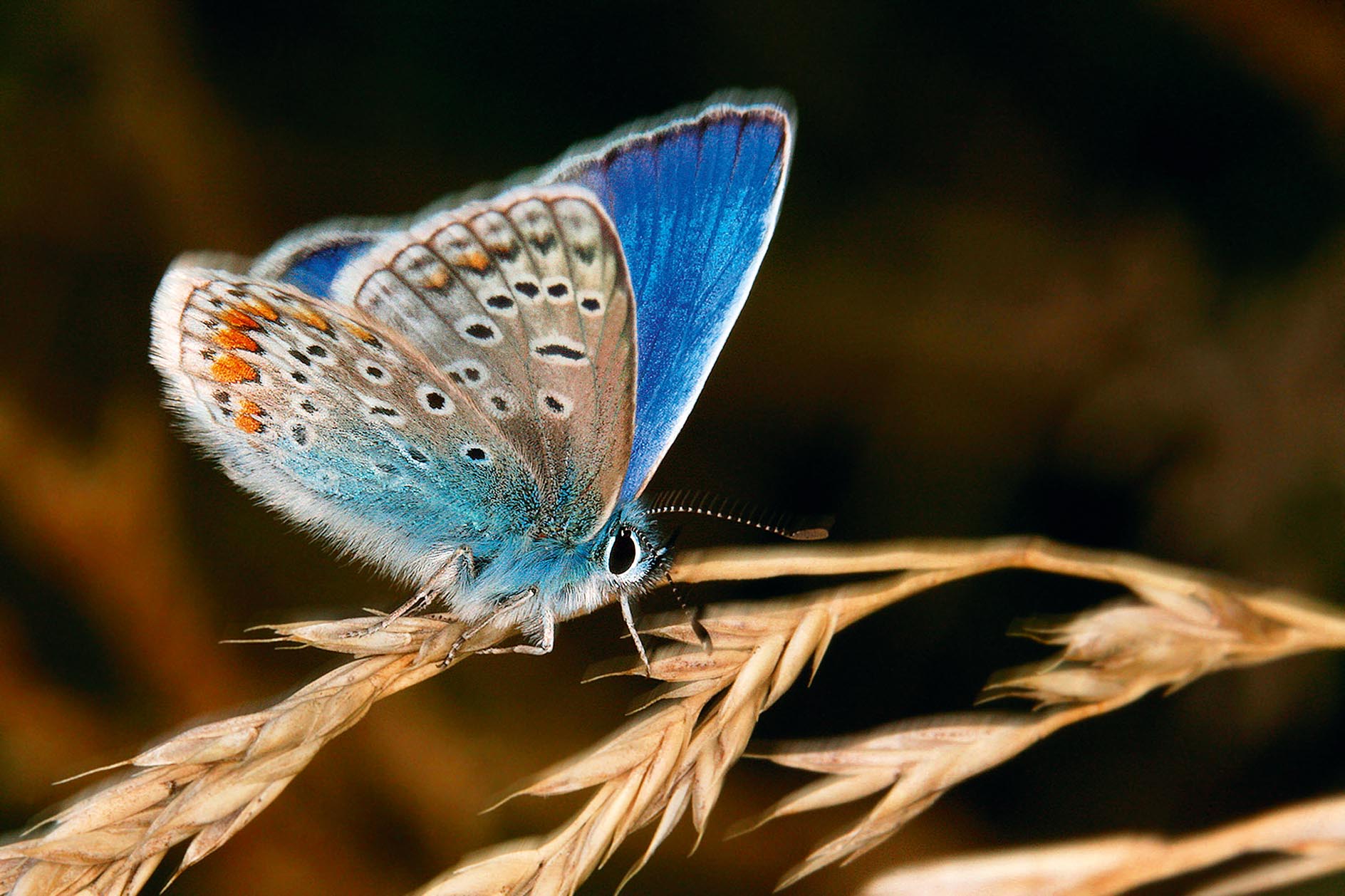The ultimate way to see The Lake District? By air, from the cockpit of an autogyro
Flying over the Lake District in a gyrocopter, Charles Harris experiences views that no man had from the dawn of time until the 20th century–and few do now.


There is a certain ecstasy in flight. Travel with no constraints of speed, boundary or traffic, surmounting geography without effort, looking down like a god or a hawk.
Some readers will have seen Greenland’s icy mountains from the transatlantic sky or deserts on the way to Asia.
Those glimpses, however, cannot compare with the joy of sitting, bracingly windswept, in a tiny open plane — an autogyro — humming low over rivers and pastures, vaulting over lofty crags and swooping along high valleys empty of all but sheep and deer.
The best place to do this is the Lake District, where I went in June. Modern autogyros (also called gyrocopters) are usually slender aircraft about 3ft wide and 15ft long.
They have no wings. Instead, an unpowered rotor provides lift and a small engine and propeller at the back give forward speed.
They can fly faster than 100mph or extremely slowly and hover into the wind. They aren’t helicopters (the rotors of which are powered) and they do not stall. Should the engine fail, you sink fairly gently to the ground. Probably.
Take off is short and landing distance is, with skill, negligible.
Sign up for the Country Life Newsletter
Exquisite houses, the beauty of Nature, and how to get the most from your life, straight to your inbox.
A Spaniard, Juan de la Cierva, invented and flew the first autogyro in 1923, crossing the Channel in one five years later.
An American, Harold Pitcairn, landed his on the White House lawn in 1931. Their greatest recent exponent was Englishman Ken Wallis, who died at the age of 97 in 2013, still holding eight of his 34 world records.
He developed the Agile model in Norfolk and provided single-seater ‘Little Nellie’ for James Bond in the 1967 film You Only Live Twice. Wallis was Sean Connery’s stunt pilot, firing satisfyingly lethal missiles to destroy the villains’ helicopters (which he could, in real life, often outperform).

I took off recently from a picturesque field between Penrith and Keswick in an (unarmed) Italian two-seater belonging to ace pilot — and entertaining instructor — Roger Savage, who has a reassuring 10,000 flying hours. (I have about 30.)
The day was windier than was ideal. The sun shone in a pale-blue sky laced with minatory cloud.
With a modest roar, we sprang briskly from the turf, then throttled back, to fly with a muffled clattering beat — and mild vibration — over the hillock of Great Mell to Ullswater (scene of Donald Campbell’s 202mph water speed record in 1955).
To the east lay the high, bleak sanctuary of the stags of Dalemain (the chatelaine of which is Jane Hasell-McCosh, founder of the World’s Original Marmalade Awards); rising to the west stood the mighty bulk of Helvellyn, with tiny figures moving along the ridge of Striding Edge, which appears less sharp from the sky than it does when you traverse it on foot.
Soon, gloomy Thirlmere lay below, seemingly ashamed to be a reservoir and not a natural lake. To the south was Helm Crag, quaintly, but aptly called in the Wainwright guide ‘irascible, like a shaggy terrier in the company of sleek hounds’.
Bearing northwest, in mere moments — for we were cruising at 70mph — we saw the refreshing glint of Derwent Water and a white steamer forging slowly from Keswick to Lodore.
The delights of our flight were marvellous: floating buoyant in the summer air, deftly absorbing or avoiding updrafts and downdrafts, thrumming softly over the tapestry of lakes and fells, skimming steep, dun-coloured slopes or the meadows where poets wandered, Ruskin enthused and Beatrix Potter conjured small animals to human life.
The views are those that no man had from the dawn of time until the 20th century — and few do now.
We had velocity brisk enough to invigorate, yet modest enough to appreciate the paths and lanes, groves, silver becks and small farms that embellish this undulating land: a mellow blend of wild slopes and tame water.
There is little here to mar the view save the occasional rash of shiny caravans. Why can’t their roofs be green or grey?

‘Now,’ I had hoped to hear from Roger in the headphones, ‘you have control.’
However, the winds were too fierce for a novice and a mild challenge even for him.
His skill was estimable in the testing, shifting air. As in a Tiger Moth, you bank to turn; the autogyro has a control stick and rudder pedals, the throttle gives nimble power adjustment.
Carefree liberation was tempered by the need to heed the fractious mountain gusts.
Soon, England’s highest mountain, Scafell Pike (3,206ft) — a jagged name for a rugged peak — loomed ahead, capped by a crumbling cairn. It is a breathless business to get there on foot, but we curved serenely over its crest, unrolling a new panorama towards the Irish Sea.
Turning north, surmounting Great Gable and the wall of Buttermere Fell, we skirted the valley of Rannerdale, where Saxon tribes annihilated a Norman army in an ambush.
As we turned for home, up came a distant view of Skiddaw (3,054ft), then a vigorous cruise along the Northern fells past the wide and windy summit of Blencathra, at the base of which live the eponymous Fell hounds.
Throttle back, check the windsock, a steep approach and we subsided with a comfortable bump onto the grass. I was sad to be down.
Autogyros attract all sorts. In 2019, adventurer James Ketchell flew one around the world in 175 days. A mayor of Keswick, Andrew Lysser, survived a bird strike over Caldbeck in 2017.
Wing Cmdr Mark Quinn, pilot of special forces’ Pumas in Afghanistan and other zones of war, finds exhilaration flying autogyros over the Lakeland hills and introducing others to the sport.
Many normally unadventurous people come to fly in Cumbria, full of anxious or trepid excitement — and invariably, the pilots say, land euphoric and smiling, rapturous after a captivating sortie in the mountain air. I can well see why.
Charles Harris QC is a former judge and author of ‘Trial and Error’ (2020) To fly with Roger Savage of Lake District Gyroplanes, visit www.lakedistrictgyroplanes.co.uk

The man who spent a year spotting all 59 of Britain's native butterflies
Once oblivious to butterflies, Robin Page became so entranced by their delicate beauty that he embarked on a year-long safari
Country Life is unlike any other magazine: the only glossy weekly on the newsstand and the only magazine that has been guest-edited by HRH The King not once, but twice. It is a celebration of modern rural life and all its diverse joys and pleasures — that was first published in Queen Victoria's Diamond Jubilee year. Our eclectic mixture of witty and informative content — from the most up-to-date property news and commentary and a coveted glimpse inside some of the UK's best houses and gardens, to gardening, the arts and interior design, written by experts in their field — still cannot be found in print or online, anywhere else.
-
 The King's favourite tea, conclave and spring flowers: Country Life Quiz of the Day, April 22, 2025
The King's favourite tea, conclave and spring flowers: Country Life Quiz of the Day, April 22, 2025Tuesday's Quiz of the Day blows smoke, tells the time and more.
By Toby Keel
-
 London is the place for me* (*the discerning property buyer)
London is the place for me* (*the discerning property buyer)With more buyers looking at London than anywhere else, is the 'race for space' finally over?
By Annabel Dixon